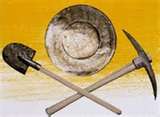Digging and dying for gold in the Guianas
The world's attention has been on the fate of legal miners trapped deep below the earth's surface. But the rare miraculous rescues and sorrowful deaths that so grasped the world are the almost daily experiences of thousands of illegal miners in a gold rich part of the Caribbean.
 |
 |
|
Small diamond miners choose the cheapest way to go for the expensive precious metal. |
Small gold and diamond miners use basic tools to dig for their future. |
Illegal mining has been causing accidents and deaths in Guyana, Surinam and French Guiana for as long as the gold industry has existed in these three Caribbean Community (Caricom) territories on the north-eastern shoulder of South America.
But the latest steep spiral in gold prices on the world market and a November 2010 accident in Surinam that killed seven illegal miners have triggered alarm bells for safety standards in the mining sector in the three territories that share common borders and boundless natural resources.
Together, they form the geologically resource rich Guiana Shield – over 175,000 square miles (462,368 square-kilometers) of mainly forested jungles inhabited by indigenous tribes of African slave (Maroon) and Amerindian origin and wild animals, contoured with mountains and meandering rivers over vast, under-explored reserves of diamonds, gold, bauxite, timber, sand and stone.
The Surinam miners died after a mudslide eroded the 65-foot wall of the open pit they were mining in and swallowed them.
Happening on the heels of the dramatic mining rescues in Chile and China in October, the Surinam deaths came just ahead of the deaths of 29 miners in New Zealand's South Island in November.
Three days of national mourning were declared by President Desi Bouterse, but such deaths are not uncommon in the Guianas. They are simply not always reported, especially when they involve the illegal miners who've crossed borders.
Small and medium miners account for the vast majority in all three states. But increasingly, the illegal miners are outstripping or challenging the legal operators.
Together, however, the numerous legal and illegal prospectors have historically employed similar crude, effective, but environmentally unfriendly traditional means to extract raw gold – shoveling, picking and digging ground, scratching soil, scraping earth and washing the gold-bearing raw material in water from nearby rivers.
Surgold, Surinam's main mining company, said the victims of the November mudslide catastrophe had illegally occupied the accident area since late last year, eventually numbering some 800 illegal prospectors utilizing dozens of excavators.
Earlier this year, the Surinam authorities complained the illegal miners were damaging the environment – uprooting trees, poisoning creeks with mercury, constructing temporary towns and villages – all in the hunt for the precious metals.
 0
0 







Go to Forum >>0 Comments